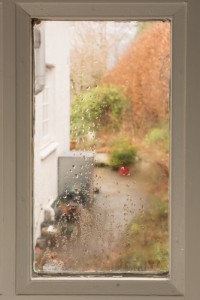You’ve seen it often, but do you know what causes condensation on home windows and sliding glass doors? Even energy-efficient windows form condensation, but they're not to blame. When high indoor humidity comes into contact with a cooler surface, such as cool glass, water vapor in the air condenses on the cooler surface. If you want to rid your home of condensation and mold risks, alleviate high indoor humidity by modifying activities and using practical indoor air quality (IAQ) upgrades.
 Condensation on Home Windows
Condensation on Home Windows
Condensation may form on home windows as water, frost or fog. The reason condensation usually appears on glass is because glass is generally a cooler material than other surfaces in the home. However, condensation also forms on HVAC equipment, water pipes, walls and baseboards.
All this water must go somewhere. Some condensation may simply evaporate, adding more moisture back to the air. When water seeps into the home structure, however, you may suffer the side effects of mold:
Mold needs moisture and an organic food source to grow. Personal items, such as clothing, leather goods and paper, are susceptible to mold contamination. When mold eats into home structure, it's difficult to eradicate. Mold may also release volatile organic compounds (VOCs) found in building materials. Mold can exacerbate respiratory ailments, and cause infections and discomforts.
IAQ Upgrades and Modifications
Home dehumidification and activity modifications are effective tools for mitigating high indoor humidity. Portable dehumidifiers may be used locally in trouble areas. Use a hygrometer to measure humidity in each room. Humidity above 50 percent should be reduced. Whole-house dehumidifiers manage indoor humidity throughout the home for complete IAQ coverage.
To reduce indoor humidity from daily activities, try the following:
- Use exhaust fans during cooking and bathing. Run bathroom fans after bathing until mirrors and windows are clear of steam.
- Add aerators and low-flow fixtures to help reduce water usage.
- Make sure the exhaust fans and clothes dryer venting expel air outside the home.
To learn more about mitigating high indoor humidity and condensation on home windows, contact Rodenhiser Plumbing, Heating & Air Conditioning. We serve the Route 495/128 area of Massachusetts.
Image via Shutterstock.com